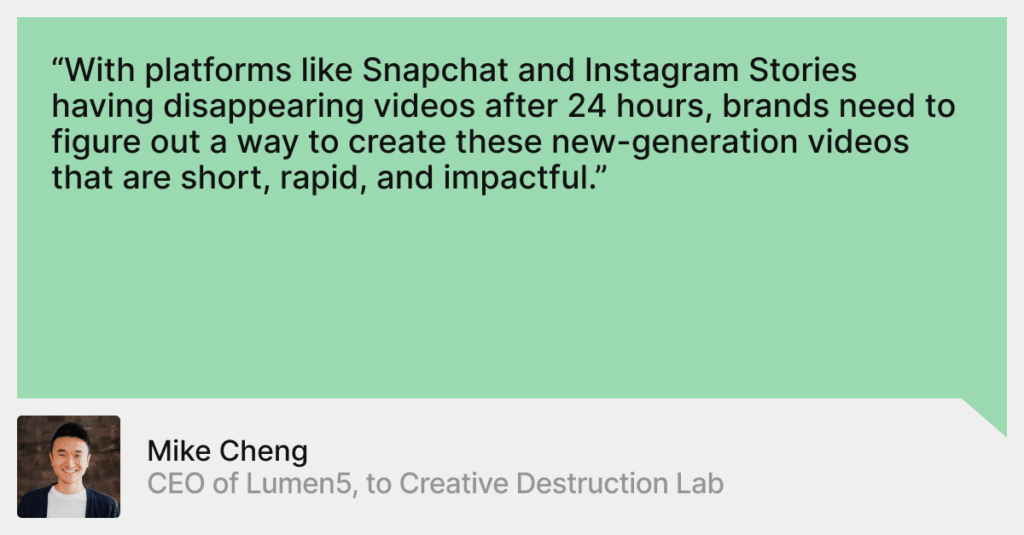AI-Generated Videos: New Reality In 2024?
Picture this: a lifelike video with characters made entirely by a computer. They fit smoothly into a story that grabs your attention and makes you feel something. But here’s the kicker: this isn’t the work of a big movie studio or a team of skilled animators drawing every detail. Nope, it’s all thanks to AI. It’s pushing the limits of what we thought was possible in video making.
Let’s take a look at Virtual Influencer Lil Miquela, who vividly demonstrates how AI is being used in video content. Lil Miquela was created by a transmedia studio – Brud, using a combination of proprietary technology, 3D rendering, motion capture, and generative AI. Her creators developed specialized technology to improve the realism of her images, used 3D rendering and motion capture for her digital persona, and employed generative AI and ML to give her context and evolve her character.
This example is just the tip of the iceberg when it comes to the evolution of video creation powered by AI. But how did it all start? What role does AI play in video creation, and which AI video generators exist out there? Let’s begin!
The evolution of AI in video creation
Before we speak about modern times and the role of AI in video creation, let’s briefly dive into the early days of AI in video creation. Where did it all start?
Early days
During the early 2000s to 2010s, AI technologies started revolutionizing video editing by introducing automation and efficiency into the process. This period saw the development of AI algorithms for tasks like object detection, scene segmentation, and automated tagging of video content, allowing editors to manipulate and organize footage more effectively. Major editing software like Adobe Premiere Pro began integrating basic AI features such as automatic color correction and stabilization, significantly improving the quality and speed of editing workflows. These advancements marked a significant shift in how video content was created and edited, laying the groundwork for further innovations in AI-driven video editing tools and techniques.
Deep learning revolution
In the 2010s, the deep learning revolution reshaped the whole concept of AI in video making. Deep learning, empowered by advancements in neural networks and abundant datasets, brought about a paradigm shift in video processing capabilities. These models facilitated intricate tasks such as facial recognition, object tracking, and semantic segmentation within videos. Major companies like Google, Facebook, and NVIDIA played pivotal roles, releasing pre-trained models and frameworks like TensorFlow and PyTorch, democratizing access to advanced AI tools. Consequently, mainstream video editing software such as Adobe Sensei, DaVinci Resolve, and Final Cut Pro X incorporated AI features like automatic scene detection, content-aware fill, and intelligent noise reduction, streamlining the editing process and enhancing video quality.
The appearance of Generative AI
Then, in 2014, Ian Goodfellow and his colleagues invented Generative Adversarial Networks (GAN). Up to the present, generative AI techniques like GAN keep facilitating the synthesis of highly realistic video content, marking a significant advancement in the field. A GAN is like a creative duo of computer programs. One program, called the generator, tries to create something, like a piece of art or a photo, from scratch. The other program, called the discriminator, tries to tell if what the generator made is real or fake. They work together, with the generator trying to fool the discriminator into thinking its creations are real and the discriminator getting better at telling what’s real and what’s not.
Indeed, with such capabilities came the rise of deepfakes. Deepfake technology, leveraging AI to manipulate or create videos of individuals saying or doing things they never did, garnered widespread attention, raising ethical concerns regarding misinformation and privacy infringement. However, AI-driven video synthesis has found applications in various domains, such as special effects, virtual production, and content creation, revolutionizing the film and entertainment industry by offering unprecedented levels of creativity and realism.
Present days
Today’s smartphones and cameras boast an array of AI features, including real-time portrait mode, immersive augmented reality effects, and seamless automatic video editing functionalities, totally revolutionizing how users capture and edit their video content.
AI video editing tools can make unique music videos, turn regular videos into fast-forward time-lapses, make fake weather or extraordinary new worlds, and even make old videos look bright and clear. They can also add effects that don’t follow real rules, change actors’ faces or voices, create cartoon characters that look real, and fix shaky or weird videos so they look fantastic. These tools make videos way more exciting and fun to watch!
Moreover, deploying AI-driven video analytics tools has become increasingly common across various sectors, facilitating tasks such as surveillance, content moderation, and personalized recommendations on popular video-sharing platforms. In today’s reality, platforms like Runway ML offer creators a user-friendly gateway to experiment with AI models, fostering video processing and synthesis innovation. Meanwhile, tools like Wipster streamline the post-production workflow through AI-driven features like automated timestamping and speech-to-text transcription, facilitating seamless collaboration among dispersed teams.
The role of AI in video creation
For those who are still wondering: Can AI generate videos? Yes. Moreover, AI has changed a lot in the creation of digital content. It’s not just about the usual ways of making videos anymore. AI is transforming everything, from the way videos are made to the ideas behind them.
In the past, making top-notch videos demanded big teams, costly equipment, and significant time investments. However, AI-driven video production has changed the game, automating processes and improving efficiency. Whether it’s tasks before filming, such as writing scripts, creating storyboards, and setting up scenes, or tasks after filming, like editing videos, mixing audio, and adjusting colors, AI can manage every aspect of the quality video creation.
So, how to make AI-generated videos? In the video generation process, creators initially plan the project’s goals and prepare content like scripts and visuals. This content is then formatted and fed into AI algorithms. AI analyzes it and then proceeds to generate or enhance various aspects of the video, such as animations, voiceovers, visual effects, or editing footage.
Of course, this situation might seem alarming for some Hollywood actors and film producers, as they fear that AI may replace a lot of jobs or will kill the whole filmmaking industry at all. However, according to Cristobal Valenzuela, CEO of Runway, (a company specializing in creating AI-generated videos, images, and multimedia content), it’s too early to talk about such global changes. Nevertheless, Valenzuela believes that AI has the potential to revolutionize the way stories are told in Hollywood. Also, the main idea behind Runway is to let anyone, regardless of their background, make videos or images just by typing words. Therefore, AI became a significant aspect of the content creation process.
Which AI video generators exist, and how do they work?
Runway
Let’s begin the discussion of AI video generators with Runway AI. Runway AI is a platform that specializes in creating products and models for generating videos, images, and various multimedia content using generative AI. It offers tools and technologies that allow users to explore creative possibilities and experiment with AI-driven content creation.
The Runway AI was created by Cristobal Valenzuela in 2018 in New York with the main idea of offering anyone, regardless of prior experience in filmmaking or design, a user-friendly platform to create multimedia content using only words. The CEO of Runway, Cristobal Valenzuela, has always pursued the idea of empowering all creators worldwide with diverse backgrounds to harness the potential of AI in their artistic endeavors. And he really made it! This accessibility, coupled with its advanced AI algorithms that can understand and express emotions, sets it apart in democratizing content creation.
Here’s a bit about Runway: Users can experiment with different effects, styles, and animations to bring their ideas to life in unique and innovative ways, making it a standout tool in video production. It’s like having your own movie studio right on your computer! Moreover, Runway’s motion brush feature allows precise manipulation of elements within images, offering a level of control and creativity unmatched by other platforms.
Thus, Runway’s suite of tools was even used by the small team behind the “Everything Everywhere All at Once” film to streamline tasks like rotoscoping, allowing filmmakers to have more free time and focus on storytelling. The result? The film became successful and won 7 Oscars, showcasing the great potential of AI-powered tools in filmmaking.
Lucas AI Video Creator
Let’s move on to the next tool – Lucas AI Video Creator. Lucas is a chat prompt-based tool that creates AI-generated videos from text. Just like in Runway, users interact with the AI through text commands or prompts. Users can simply type out their requests or ideas, and Lucas AI will generate the corresponding video content. Interestingly, Idomoo, the creator of Lucas, claims that Lucas is much easier than Runway.
Creating a video with Lucas is truly a quick process that takes less than a minute from start to finish. Users can spend additional time customizing the video using the intuitive built-in editor. Once Lucas generates a video, users can click “Edit Video” to fine-tune elements such as voiceover, on-screen text, and media. The history tab allows users to access and review videos created within the last 30 days, facilitating project tracking and management.
Besides, Lucas is a functional plugin accessible to GPT-4 users on the ChatGPT store, allowing effortless conversion of ChatGPT responses into fully usable videos within seconds. Of course, this approach makes video creation accessible to a wider audience, as users do not need specialized technical skills or knowledge to use the tool.
Lumen5
Lumen5 is another online platform that allows users to create videos from text content using AI. Lumen5 was founded in 2017 in Vancouver, Canada, by Michael Cheng and Nigel Gutzmann. The platform appeared from a desire to democratize video creation and make it accessible to everyone, regardless of technical expertise. Since its inception, Lumen5 has grown rapidly, attracting users worldwide and evolving to offer innovative features that streamline the video production process.

With Lumen5, users can choose from various templates or start from scratch to customize their videos, and the platform provides tools for text formatting, adding media, and adjusting the video’s duration. Like Runway and Lucas, Lumen5 also aims to make video creation more accessible for individuals and businesses without extensive video editing experience.
For example, Siemens improved its digital communications with Lumen5, empowering employees worldwide to create high-quality video content quickly and affordably. With over 4,360 videos created in the past 12 months, Siemens achieved a 98.3% faster turnaround time and reduced production costs by 25x compared to using agencies.
AI-generated videos market outlook
Nowadays, we are undoubtedly in the era of video content. With people’s significant consumption of videos, there is a substantial demand for tools using AI to create videos.
The global AI video generator market is rapidly growing because more and more people use technology in everyday life, including at work. Thus, people create AI video generators for purposes such as marketing, education, entertainment, communication, and training, using them to produce promotional content, instructional videos, entertainment media, communication messages, and training materials.

According to the latest research, the worldwide market for AI video generators was valued at $415 million in 2022. Projections indicate it will soar to $2,172 million by 2032, with an anticipated highest CAGR of 18.5% between 2023 and 2032.
For most people, videos indeed offer an easier way to consume information compared to reading, prompting companies to develop improved AI video tools. Emerging technologies such as the Internet of Things and cloud-based tools are driving the popularity of AI video generators, particularly in educational institutions and online retail, while the prevalence of funny memes and GIFs in messaging platforms further contributes to the increasing popularity of these tools. All in all, the growing demand for educational videos, tutorials, and sports clips is fueling the expansion of the market, which is projected to continue growing at a rapid pace.





